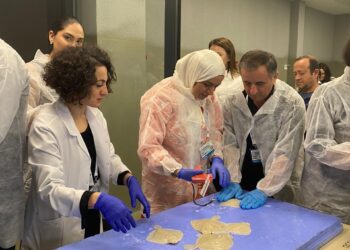Sustainable shrimp, seaweed and oyster farming – A recent study conducted by the University of New Hampshire revealed that integrating farmed shrimp with oysters and seaweed in integrated multitrophic aquaculture (IMTA) systems can significantly reduce nitrogen levels. This method could make shrimp farming more sustainable and support the growth of the US industry.
Shrimp farming and its environmental impacts
Shrimp farming has seen rapid expansion in the subtropical and tropical regions of Asia and the Americas, fuelled by growing demand in developed countries. However, this industry is also responsible for significant environmental impacts, such as increased ammonium levels that can cause harmful algal blooms (HABs) and oxygen-deprived dead zones.
Elizabeth Martin, a graduate student in the marine biology programme at UNH’s College of Life Sciences and Agriculture (COLSA), pointed out that much of the shrimp consumed in the US comes from abroad, where environmental regulations are less stringent. Martin highlighted the importance of developing a local industry to reduce dependence on imports and improve sustainability.
The study on IMTA systems
Martin’s research focuses on IMTA systems, which combine farmed shrimp with filter-feeding species, such as oysters, to reduce the amount of ammonia and phosphorous in the water. In natural environments, molluscs filter out excess nutrients, cleaning the water. Martin tested whether a similar method could work in a closed farm system, using native oysters and non-native red algae together with Pacific white shrimp.
Promising results
The research team tested three different configurations: shrimp with seaweed, shrimp with seaweed and an oxygenator, and shrimp with seaweed and oysters. The final treatment, which combined shrimp, algae and oysters, showed a significant reduction in nitrogen levels, including ammonia, nitrite and nitrate, over a 30-day period.
Oysters proved effective in controlling nitrogen production, contributing significantly lower levels than other treatments. This approach not only makes shrimp farming more sustainable, but also produces marketable algae and oysters, diversifying income sources for aquaculture farms.
Future prospects and challenges
Although there are challenges related to regulatory issues and environmental concerns specific to the United States, the study offers a path towards more sustainable aquaculture practices. Michael Chambers, associate research professor at the UNH School of Marine Science and Ocean Engineering and Martin’s advisor, pointed out that this new IMTA approach could allow shrimp to be grown indoors, such as barns or greenhouses, offering fresh fish to local restaurants.
The research represents a significant step towards more responsible and sustainable shrimp farming. Integrating oysters and seaweed into aquaculture systems could reduce negative environmental impacts and support the growth of the US industry. This innovative method not only improves water quality, but also offers new economic opportunities for fish farmers, making aquaculture a more sustainable and prosperous industry.
Sustainable shrimp, seaweed and oyster farming








